London Plane Tree Traditional Geocache
-
Difficulty:
-

-
Terrain:
-

Size:  (other)
(other)
Please note Use of geocaching.com services is subject to the terms and conditions
in our disclaimer.
London Plane Trees are hybrids between American Sycamore and Oriental Plane.
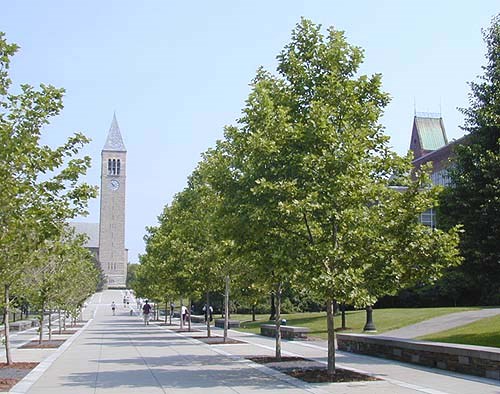
That was then. When?
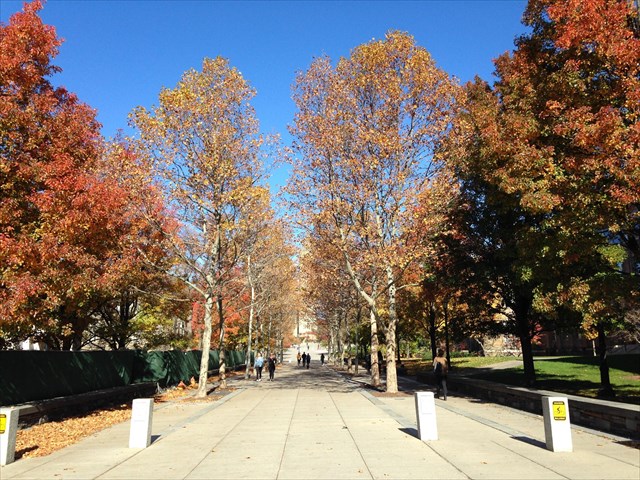
This is now, 11/12/2016
London Plane Tree
Platanus × acerifolia, London plane, London planetree, or hybrid plane, is a tree in the genus Platanus. It is usually thought to be a hybrid of Platanus orientalis (oriental plane) and Platanus occidentalis (American sycamore). Some authorities think that it may be a cultivar of P. orientalis.
Description
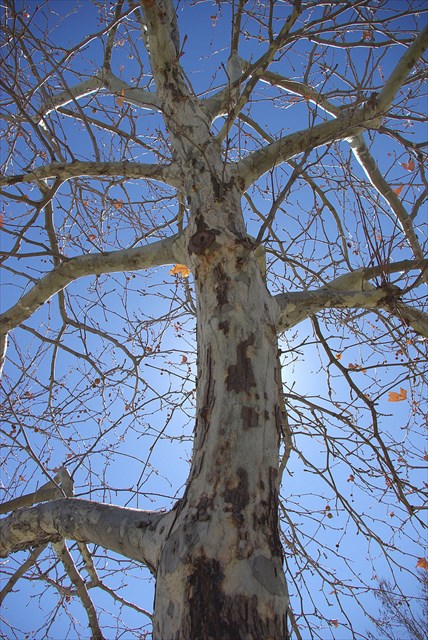
London plane in NMSU
The London plane is a large deciduous tree tree growing 20–30 m (66–98 ft), exceptionally over 40 m (131 ft) tall, with a trunk up to 3 m (10 ft) or more in circumference. The bark is usually pale grey-green, smooth and exfoliating, or buff-brown and not exfoliating.

The leaves are thick and stiff-textured, broad, palmately lobed, superficially maple-like, the leaf blade 10–20 cm (4–8 in) long and 12–25 cm (5–10 in) broad, with a petiole 3–10 cm (1–4 in) long. The young leaves in spring are coated with minute, fine, stiff hairs at first, but these wear off and by late summer the leaves are hairless or nearly so.

The flowers are borne in one to three (most often two) dense spherical inflorescences on a pendulous stem, with male and female flowers on separate stems. The fruit matures in about 6 months, to 2–3 cm diameter, and comprises a dense spherical cluster of achenes with numerous stiff hairs which aid wind dispersal; the cluster breaks up slowly over the winter to release the numerous 2–3 mm seeds.
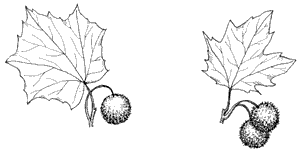
Sycamore left, Plane right
It shares many visual similarities with Platanus occidentalis (American sycamore), of which it is derived; however, the two species are relatively easy to distinguish, considering the London plane is almost exclusively planted in urban habitats, while P. occidentalis is most commonly found growing in lowlands and alluvial soils along streams.
Origin

London plane in Whittier College
The species was formed by hybridization in the 17th century after P. orientalis and P. occidentalis had been planted in proximity to one another. It is often claimed that the hybridization took place in Spain, but it could also have happened in Vauxhall Gardens in London where John Tradescant the Younger discovered the tree in the mid-17th century. The leaf and flower characteristics are intermediate between the two parent species, the leaf being more deeply lobed than P. occidentalis but less so than P. orientalis, and the seed balls typically two per stem (one in P. occidentalis, 3-6 in P. orientalis). The hybrid is fertile, and seedlings are occasionally found near mature trees.
Controlled reciprocal pollinations between P. occidentalis and P. orientalis resulted in good yields of germinable seed and true hybrid seedlings. Crosses of both species, as females, with P. racemosa and P. wrightii produced extremely low yields of germinable seed, but true hybrids were obtained from all interspecific combinations. Apomixis (asexual reproduction from non-fertilized seeds) appeared common in P. orientalis.
In 1968 and 1970, Frank S. Santamour, Jr., recreated the P. orientalis, P. occidentalis cross using a P. orientalis of Turkish origin with American sycamores (P. occidentalis). The offspring were evaluated following several years of exposure to anthracnose infection. Two selections, 'Columbia' and 'Liberty', were released in August, 1984.
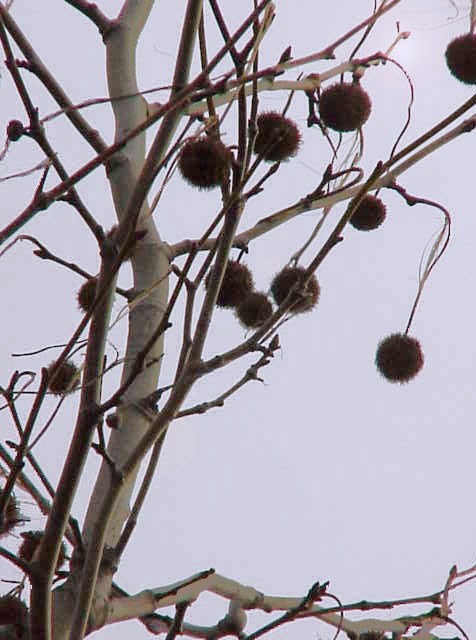
London plane (Platanus × acerifolia) - note single seed ball per stem: similar to P. occidentalis, not found in all clones
Leaves
The London Planetree has alternate leaf mosaic, lobed leaf shape, palmate leaf venation, and dentate leaf margins.
Taxonomy

This example, Topcider Park, Belgrade, was planted in 1834
Platanus × acerifolia was first formally described in the botanical literature by the Scottish botanist William Aiton in his 1789 work Hortus Kewensis as a variety of P. orientalis. Aiton described this variety with a two-word Latin diagnosis, "foliis transversis", and called it the Spanish plane tree.In 1805, Carl Ludwig Willdenow chose to elevate Aiton's variety to species rank, publishing the new species P. acerifolia in the fourth edition of Species Planetarium. The species name was then modified to include the multiplication symbol to indicate its suspected hybrid parentage.
Cultivation

Foliage close-up seen near Westminster Abbey
The London plane is very tolerant of atmospheric pollution and root compaction, and for this reason it is a popular urban roadside tree. It is now extensively cultivated in most temperate latitudes as an ornamental and parkland tree, and is a commonly planted tree in cities throughout the temperate regions of the world, in London and many other cities. It has a greater degree of winter cold tolerance than P. orientalis, and is less susceptible to anthracnose disease than P. occidentalis.
The tree is fairly wind-resistant. However, it has a number of problems in urban use, most notably the short, stiff hairs shed by the young leaves and the dispersing seeds; these are an irritant if breathed in, and can exacerbate breathing difficulties for people with asthma. The large leaves can create a disposal problem in cities. These leaves are tough and sometimes can take more than one year to break down if they remain whole.
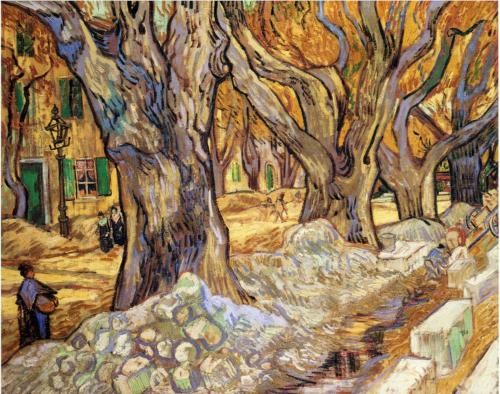
London planes are often pruned by a technique called pollarding. A pollarded tree has a drastically different appearance than an unpruned tree, being much shorter with stunted, club-like branches. Although pollarding requires frequent maintenance (the trees must usually be repruned every year), it creates a distinctive shape that is often sought after in plazas, main streets, and other urban areas.

In New York City
The tree is on the NYC Parks Department's list of restricted use species for street tree planting because it constitutes more than 10% of all street trees.
In Australia
In Australia, the London plane is used extensively as a street tree in major cities, particularly Sydney, Melbourne and Adelaide.The tree is commonly used because of its resilience to warm weather, its benefits as a shade tree, resistance to breakage and tolerance of urban pollution.
Timber
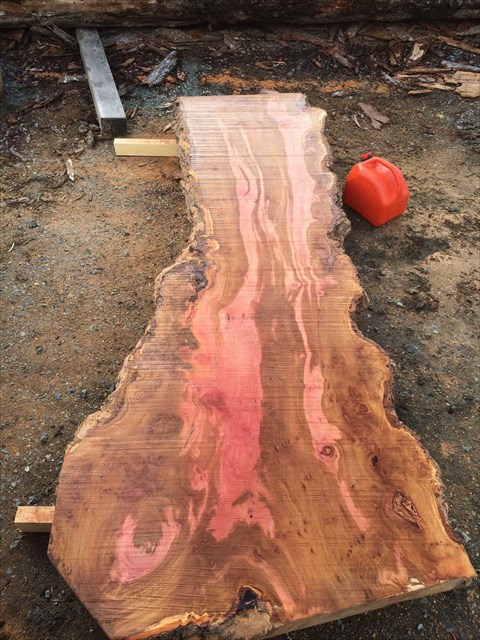
When quater-sawn the timber has a distinctive and highly decorative appearance of dark reddish-brown flecks
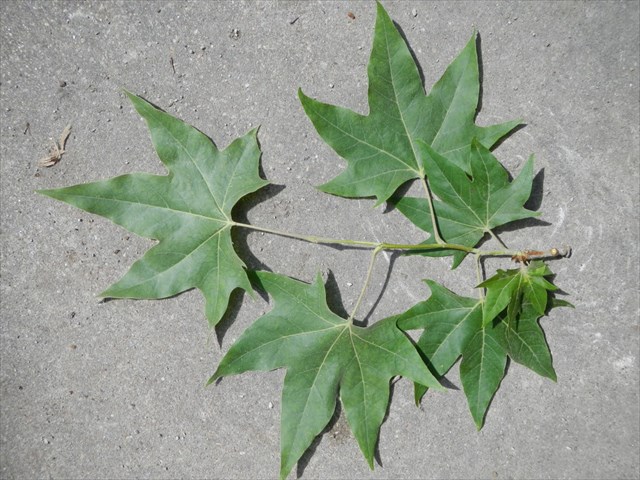
This hybrid can be very difficult to distinguish from its American parent. Distinguishing features include: (1) Leaves have deeper sinuses and (2) fruiting balls appear in pairs.

Mature trees typically display mottled white bark that facilitates identification from great distances. The large 3-5 lobed medium to dark green leaves (4-9” wide) have coarse marginal teeth.
Small, non-showy, monoecious flowers appear in small rounded clusters in April. Male flowers are yellowish and female flowers are reddish.

The fruit of a London Plane hanging on the tree, taken in England in Autumn.
Female flowers give way to fuzzy, long-stalked, spherical fruiting balls (to 1 3/8” diameter) that ripen to brown in October and persist into early winter. Fruiting balls appear in pairs.
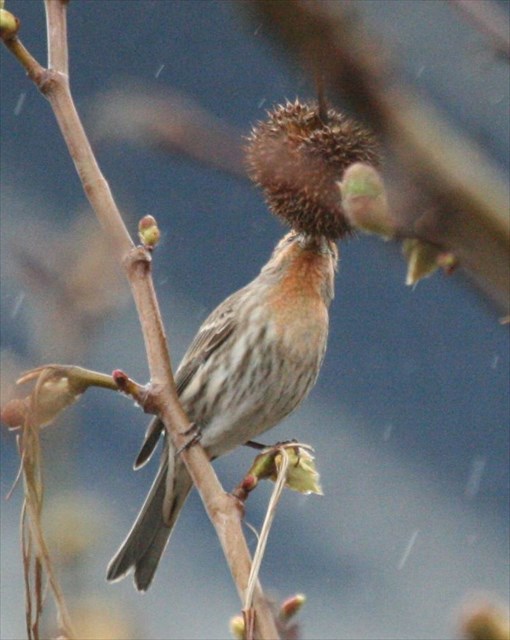
A house finch eating London plane seeds in Seattle

This is the GZ tree, cache nearby
The cache is a tied in and camoed. Please BYOP and put everything back as you found it. Please report if anything is amiss; rubber band missing, plastic bag torn, fishing line broken or such.
Additional Hints
(Decrypt)
Uvqqra ol fabj?